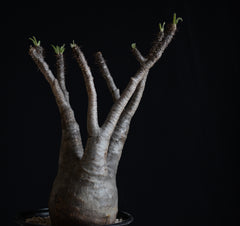Pachypodium Rosulatum ssp. Gracilus
| Plante | Sol | Vand sommer | Vand vinter | Dvale | Jord | Udbredelse |
| Pachypodium Gracilius | max | middel | - | vinter | blandet | Madagascar |
Pachypodium Rosulatum ssp. Gracilius (eller var.) kaldes for det meste bare P.Gracilius.
Planten vokser i det centrale Madagascar syd for hovedstaden på Isalo bjergene 300-1000meter over havets overflade. Planten minder en del om Pachypodium Rosulatum men bliver ikke så høj og har kortere grene. Derfor opnår der ofte en næsten ballon agtig form og kan derfor være en af de mest særegne og skulpturelle caudiciformer.
Mindre eksemplarer af P.Gracilius har endnu ikke fået den pachycaule form og minder ofte om Pachypodium Lamereii og Mikea med regelmæssige blade og torne på hele stammen, og med forgrening helt nede ved roden.
Planten skal have så meget sol som muligt, og vandes i vækstperioden ofte. Om vinteren november til marts vandes den stort set ikke. Begynd og vand den sparsomt i slut februar igen som solen og varmen tager til. Den er løvfældende og har slet ikke blade i dvaleperioden. Det siges at planten skal have mindre og mindre vand jo ældre den bliver.
Planten vokser i naturen på sandstensklipper ved en pH værdi på 4.5.
|
Generelt om Pachypodium Der er en række regler man med fordel kan følge når man dyrker Pachypodium uanset art. Brug små potter. Bruges der store potter får planten ofte for stort rodnet, og så bruger planten mere energi på at vækste grenene, og dermed får man ikke den kompakte form, som de får i habitat, og som er flottest. Med små potter menes en potte der ikke er meget bredere end selve caudex, og ikke meget højere end caudex. Brug et rent mineralsk vækstmedie, som f.eks. pimpsten, eventuelt blandet med noget perlit. Begge mineraler holder lidt på vand, men lader større mængder vand trænge i gennem en potte og ud igen. I naturen vokser de fleste Pachypodium'er direkte på granit, kvarts, kalksten og sandsten. Gød ved hver vanding. Brug en lav koncentration af gødning, og husk at gødningen i alt det vand der ryger ud af potten igen ved vanding ikke optages af planten. Hold altid planten en smule fugtig - også om vinteren. Det lyder måske lidt modsat at planterne skal holdes tørre om vinteren for at undgå råd, men husk at man også kan vande en meget lille smule i udkanten af potten, væk fra planten. Pachypodium skal have meget vand om sommeren, gerne hver anden dag. Særligt Brevicaule reagerer meget stærkt på udtørring. Pachypodium er i dvale december til februar (ca.), blomstrer fra april til juni, og vokser fra juni til november. De fleste Pachypodium skal have minimum 4 timers direkte sol i blomstrings- og vækstperioden fra februar til november. Kun Pachypodium bør holdes over 10°Celsius om vinteren - Bispinosum og Succulentum kan dog tåle ned til 0 grader. På trods af denne anbefaling vokser en del af Madagascar Pachypodium'erne dog på steder hvor det om vinteren bliver ned til 5°, og i højder hvor det sandsynligvis kan blive endnu koldere. De fleste Pachypodium (men ikke alle) vokser i naturen i jord med en lav surhedsgrad omkring ph 4-5. Kalk. Kalk i vandet hæver ph værdien, så det kan anbefales at demineralisere vandet (koge det) før vanding, eller bruge regnvand. Nogle Pachypodium - særligt Brevicaule skulle være følsomme overfor bakterier, det kan måske forklares med den lave ph værdi i deres habitats jord, da bakterier ikke klarer sig så godt i sure miljøer. |

Den bør planten i en blanding af sten/grus og en smule humus. I naturen vokser den direkte på sandsten i revnerne hvor en smule jord kan sidde fast.
Planten er relativt nem at formere fra frø, men den vokser langsomt så man skal have tålmodighed for at opnå ballonformen.
Hos Caudiciform.com dyrker vi Pachypodium Gracilius fra frø, men de sælges først når de har nået en vis størrelse. Skriv til os hvis du er interesseret i mindre eksemplarer.


Frø af Pachypodium Rosulatum ssp. Gracilius
